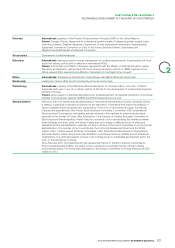APC 2015 Annual Report Download - page 57
Download and view the complete annual report
Please find page 57 of the 2015 APC annual report below. You can navigate through the pages in the report by either clicking on the pages listed below, or by using the keyword search tool below to find specific information within the annual report.
2015 REGISTRATION DOCUMENT SCHNEIDER ELECTRIC 55
SUSTAINABLE DEVELOPMENT
2
SUSTAINABLE DEVELOPMENT ATTHEHEART OFOURSTRATEGY
1.5 External and internal referentials forasolid framework
The Sustainable Development Department
The Sustainable Development Department, created in 2002,
has been part of the StrategyDepartment since2008. It has the
following responsibilities:
•defi ning Schneider Electric’s sustainable development strategy
and rolling out action plans at the Group level with the concerned
entities;
•developing and managing Schneider Electric’s innovative
community projects to ensure continuing improvements in the
Group’s performance in this area.
In2010, the Sustainable Development Department was adapted
to better meet the c ompany’s present and future challenges as well
as the requirements of its stakeholders. It is organized around four
areas:
•ethics, steering the Responsibility & Ethics Dynamics program
(see pages65-68 );
•social responsibility, specifi cally with the Schneider Electric
Foundation as well as local economic and social development
programs (see pages98-103 );
•access to energy, with responsibility for the Access to Energy
program (see pages 93-98 );
•supporting and developing the Group’s performance, in particular
by steering the Planet&Society barometer and the strategy and
sustainability report (see pages48-49 ).
Global Supply Chain organization, with
responsibilities including Safety and the
Environment
(seepage 70 ).
Human Resources organization
(seepage79 ).
The board of directors
In 2013, the board of directors decided to extend the powers
of the Remuneration Committee to issues of corporate social
responsibility. Since 2014 there has been a specifi c committee for
CSR: the Human Resources and CSR committee (see p. 147 )
The Sustainable Development Executive Committee
Since 2010, the three members of the Executive Committee in
charge of Human Resources, Global Supply Chain and Strategy
have met two to three times per year with the Sustainable
Development Director to monitor and steer the Group’s action plans
in this area.
The Ethics Committees
(seepage66 ).
External referentials
The United Nations Global Compact
The Global Compact was launched in 1999 by UN Secretary-
General Kofi Annan. It brings companies and non-governmental
organizations together under the aegis of the United Nations to
«unite the power of markets with the authority of universal ideals».
Parties signing the Global Compact commit to 10 fundamental
principles in four areas: human rights, labor rights, the environment
and anti-corruption.
By signing the Global Compact in December 2002, Schneider
Electric made a public commitment to these universal values. The
Group has primarily worked to share this commitment with its
partners since2003 (see page63 «Relations with sub-contractors
and suppliers»).
In line with the requirements of the Global Compact, Schneider
Electric publishes an annual Communication on Progress (COP).
This publication reports on the Group’s different action plans and
monitoring indicators for the 10 principles of the Global Compact.
Schneider Electric meets the requirements of the Advanced Level
of the Global Compact with this report for COP.
ISO26000
In 2010, the ISO (International Organization for Standardization)
published its guidelines on organizations’ social responsibility
(ISOstandard 26000). ISO26000 promotes a compromise involving
different players from the public, private and non-profi t sectors
from around 100 countries , and a vision of how an organization
should view societal responsibility. Schneider Electric’s actions
towards sustainable development are committed to ISO 26000.
This standard legitimizes the sustainable development actions
undertaken by the Group since the early 2000s and provides an
educational support and framework for its actions in the fi eld. The
Group has worked to promote the adoption of the principles of
ISO26000 with its suppliers since2012 (see page63 «Relations
with sub-contractors and suppliers»).
The Global Reporting Initiative
The Global Reporting Initiative (GRI) was established in 1997 as
a mission to develop globally applicable directives to report on
economic, environmental and social performances; it was initially
intended for companies and subsequently for any governmental or
non-governmental organization.
Brought about by the Coalition for Environmentally Responsible
Economies (CERES) in association with the United Nations
Environmental Program (UNEP), the GRI integrates the active
participation of companies, NGOs, accounting bodies, business
associations and other stakeholders from across the globe.
Schneider Electric aligns its non-fi nancial reporting with GRIand,
until 2013, scored a B+ with respect to GRI 3.1. In 2014, the Group
began to align with GRI 4, at the «In accordance – Core» level. A
reference table with theseindicators and the indicators proposed
by GRIisavailableonSchneiderElectricwebsite.
























